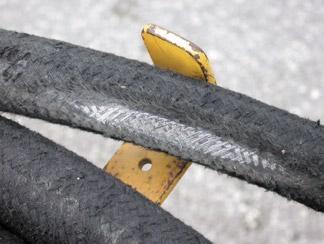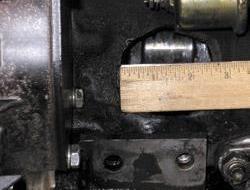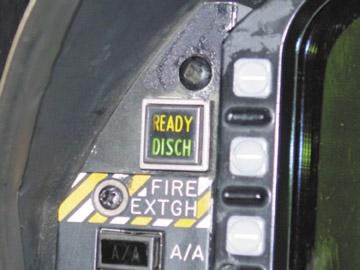
5 minute read
Good, Bad and Ugly
from MECH Fall 2006
Even simple tasks demand you wear protective equipment. Ask the question, what is the worst thing that could happen? And plan accordingly.

Advertisement
Running a piece of support equipment with no oil can lead to a problem like this 3-inch hole. Do required inspections and service equipment correctly.


Dragging a hose while moving a cart or moving it across a rough surface can be dangerous. Check hoses before using.






By AME2(AW) Petra Freund

Knowing aircraft systems and associated lights is critical to safe maintenance.



With two days left before an upcoming boat detachment, we had lots of work left to do. It was late in the day, and my shop was called for an all-hands turn on aircraft 301. Little did I know the aircraft would need a lot more work before the day was over.
The AE1 doing the low-power turn completed his walkaround and climbed into the cockpit. After completing switch checks and before turning on the battery, he made sure all fire lights were reset. After turning on the battery, he noticed the ready/discharge light was illuminated. He immediately turned off the battery and notified the AME shop.
The presence of this light indicated that our fireextinguishing system was armed and ready to discharge the bottle. Having seen this anomaly on other occasions, I didn’t think a lot about it and started troubleshooting the gripe. No, I didn’t bring a pub with me, as you probably guessed, and that fact turned out to be crucial.
While troubleshooting from the hip, I had my AME3 make sure the AE1 had turned off the battery and reset the switches. I then pulled the circuit breaker to reset the system. We had the AE1 turn on the battery, again, to see if the system had reset. It hadn’t. After being assured that the battery was off again, I tried to test the system once more. As I pulled the circuit breaker, we heard a loud pop. I immediately knew that we had inadvertently set off the fire bottle. Finally getting the ready/discharge light reset, we headed into maintenance control.
As you can imagine, the next couple of hours were utter chaos. I had to explain what had happened to maintenance control, place an emergency CAD order to replace the expended ordnance, remove the fire bottle from the aircraft, and start an investigation.
After filling out my statement, I finally got to go home—although much later than expected. I spent that night wondering why I hadn’t brought the pub with me. It could have saved me a lot of heartache in the long run.
The next morning, I read the pass down from night check and was relieved to see they found two of three components that disrupt power to the fire bottle had been shorted out, sending just enough voltage to the system to set off the CADs.
Although a short was found to have caused this incident, I learned I had become complacent even with years of experience with resetting ready/discharge lights. I simply didn’t take the job seriously, as I should have. It had become routine for me to just reset everything. No one was hurt in this mishap, and the monetary damages were small. However, the chances
Removing and replacing a brake assembly on an aircraft is just one of many routine tasks that personnel do in every airframes shop. We had one that required no less caution than any other maintenance task that involves opening any pressurized hydraulic systems. Of course, we didn’t pay attention.
With that situation in mind, an airman and an AM2 took most of the necessary precautions, which included bleeding the system to obtain the zero PSI reading required to disconnect any hydraulic line. They started removing the brake assembly and plugging the hydraulic lines that connect to it. In the process of installing the new assembly, the two maintainers proceeded to reconnect the lines. While taking off the plug of someone getting injured is always present, especially when dealing with explosives. The No. 1 lesson I learned from the whole ordeal was to always use the pubs. It can mean the difference between fixing a discrepancy the correct way or causing injury, damage, or a lot more work.
Reflecting on both the successes and the close calls of the past year, my skipper asked each of us to ponder, “Are we good or simply lucky?” I’d prefer to depend on being good.
Petty Officer Petra Freund works in the AME shop at
By Anonymous Maintainer at VR-56
VFA-113. on a brake hydraulic line, the airman’s wrench slipped, mishap. The command drove the airman to medical and Skydrol hydraulic fluid splashed in both of his eyes. where he was treated and released the same day. This problem would have been avoided had the airman Skydrol is highly corrosive and could have caused been wearing his face shield, as required in the MSDS. permanent damage, but the rapid medical care saved The airman’s immediate reaction was to close his eyes the airman’s sight. He returned to work the following because of the burning sensation and piercing pain day with no permanent damage. from the Skydrol fluid. Sometimes the simplest, most routine tasks are the
Unable to see and a bit disoriented, he pried open most hazardous because people often become complaone eye, despite the pain, and located the AM2, who cent and ignore the required precautions. Always wear immediately drove him to the nearest eyewash station. PPE, and make sure people around you do, too. Your A QAR assisted with the injury and documented the life and eyesight may depend on it.












